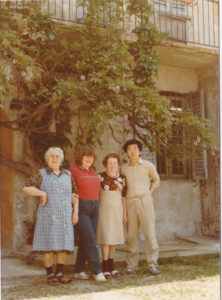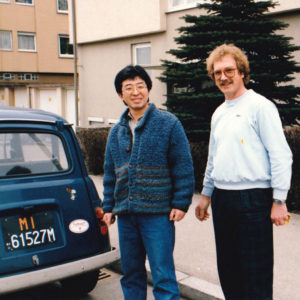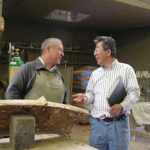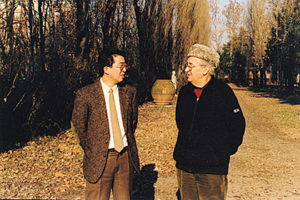Encountering Noh in Japanese Culture
- Matsumoto

- When moving overseas, why did you choose Milan?
- Maruyama
- I had a close friend who went there. I found his work surprisingly different. I was also drawn by the appeal of Italian sculpture; nothing else appealed to me as much.
- Matsumoto
- You began your re-location to Europe with 10 years in Milan, and then you moved on to Germany. All told, you spent close to 20 years in those two countries. How different were those two countries from each other in terms of the sculpting environment?
- Maruyama
- Italy seems like an open culture; but, compared to Germany, it’s quite the opposite. Maybe you could say that human relations are disengaged. Another thing was that I was in Milan at a time when culture was waning. What I felt amidst all of that was my identity as a Japanese. Other people would ask me many questions about things Japanese, like Buddhism. But I couldn’t give them answers. I realized that if I knew nothing of Japanese culture, despite being a Japanese person, then how would I be able to get a read on their culture? That’s when I began to study Japanese culture.
- Matsumoto
- You wrote about Noh in your graduation thesis at Accademia Belle Arti in Milan. That was likely due to your experience in Italy; but, did you actually like Noh up to that point?
- Maruyama

- No, I didn’t. There was a festival in Milan called ‘The Year of Japan,’ and Noh actors came to demonstrate Noh. I thought that was great. I wanted to give studying Noh a try for my graduation thesis. When I actually got down to studying it, I found that the method behind Noh was very sculpture-like. That is to say that, in Noh, the players are male. In many cases, Noh shows women in an elegant form, and these elegant women parts had to be played by a male. Further to that point, the stiff clothing worn by the actors foists a further layer of restriction on them. By putting the actors into a position where they cannot easily express themselves, the actor is forced to extract the essence of the role; and, that’s exactly what sculpture is all about. In that medium, expression isn’t achieved from brush to paper, but by giving form to an actual material, like stone, clay, or wood, and from that a variety of constraints emerge.
- Matsumoto
- I imagine there’s also resistance by the material that stops the artist from making it exactly the way they want it.
- Maruyama
- I thought, at that point, what is the most constraining material available to me now? In Milan, the most familiar material was plaster. Plaster may seem like an easy material to work with, but when dissolved in water for use, it doesn’t take form in the same way as clay. It can be a very difficult material to work with. So the clay techniques I was using in university in Japan were not applicable to plaster. By putting myself in that difficult position, I was attempting to find out exactly what it was I wanted to do.
- Matsumoto
- You then travelled to Germany. You were, by then, a free artist. You must have changed significantly. You weren’t in a university, and you had to make a whole new human network from scratch to create and exhibit your work.
- Maruyama

- Yes, that’s true. I couldn’t speak the language, so I just searched around aimlessly. My wife had connections in Fellbach, so I moved there. The city gave me opportunities to meet others, and I got to know people there.
- Matsumoto
- Your work, whether it be with wood or bronze, is characterized by its high precision, with protrusions, curves, and twists; I think the people in Germany must have been taken aback by your work. What was their reaction like?
- Maruyama
- They often commented how my work was very Japanese-like. They said it was Eastern in character.
- Matsumoto
- How is it Japanese-like or Eastern? Could it be in the refinement of the form?
- Maruyama

- I think that might be the case. I believe my work gives off a different aura than what they’re used to—it’s the atmosphere, or mood. Simply placing a sculpture can imbue a space with character, so, in that sense, I think the essence of the space differs.
- Matsumoto
- Your work most certainly has character. It’s not ostentatious; and, if I were asked whether it was verbose or reticent, I would consider it subdued. It seems to be in a form where everything is perfectly placed in its proper position on every surface and every ridge, including all of its scars and pits. That’s the precision that draws the eye. I think that’s the aspect of your work that the Germans probably admire (laughs).
Casting Eastern thought into sculpture
- Matsumoto
- Your work around the end of your 10 years in Italy was marked by the human form with block-casting of shoulders and hips. But you went in quite a different direction to realistic human forms. You began in Japan basically working with the human form, and this is quite different to your abstract turn. What difficulties did you face as a sculptor during your time in Italy?
- Maruyama

- I believe the motif I was expressing shifted from being emotive to being logical. It shifted once I began to study Noh. French playwrights say that drama happens on the Western stage. However, with Noh, it’s not about the drama, it’s about the appearance of a character. Characters simply appear on stage as they are. So, I think the stories are also very simple with Noh. In that sense, similar to sculpture, Noh shows human existence, itself. So, if I wanted to somehow put the expressive methodology of Noh into my work, it’s only natural that the theme would gradually shift as well. So, rather than vague suffering or other types of emotive elements I had been using up to now, I ended up considering what existence actually is. I tried to get a structural understanding of how human beings exist as human beings.
- Matsumoto
- In the past, you’ve said, “I’m not seeking the kind of simplification that chips away, but the kind of simplification that envelopes.” That seems like a koan from Zen, but this becomes easier to understand with your work right in front of me. However, that kind of simplification isn’t readily found outside of your work; yet, having said that, the Noh mask does come to mind. The face of the Noh mask, in a sense, contains everything—anger, sorrow. I think that, in the sense that the mask’s expression doesn’t harbor a particular emotion, but all of them, your work resembles a Noh mask.
- Maruyama
- When one chips away at a human form, they get lines; but, I think it’s more like a large frame that includes the entirety of the form.
- Matsumoto
- So it isn’t a simplification of exclusivity, but a sympathetic abstraction embracing everything. I see; so, that’s how these sculptures come about. That’s very fitting. I haven’t heard it worded that way before; what informed your thinking about this?
- Maruyama
- It was Eastern philosophy that informed my thinking. To be exact, it was Buddhism. Buddhism offers explanations for existence. For example, the world, as well as humans, is about discrimination; everything is unto itself. Each situation, face, and condition is different from each other. But, it’s all here together in the now.
- Matsumoto
- I understand now how Buddhism and Noh are continuous guiding principles in your work. Coming back to your larger theme of existence, as well as existence—relationship; existence is standalone from relationality with objects, like a table or notebook. But with people, existence is not possible without relationality to the surrounding environment nor without other people. This phrase: existence—relationship or ‘human existence is relationship;’ was it you that first posed this phrase? Is this also from Buddhism?
- Maruyama
- Yes. It is, after all, a thematic element of Buddhism—how are we to live. It’s not about what happens after we die, but how do we live now. I think that’s extremely important to anyone.
- Matsumoto

- It’s quite mysterious. From the European perspective, that’s an Eastern characteristic. However, if I hadn’t heard it directly from you, I wouldn’t have interpreted it as Eastern or Japanese-like.
- Maruyama
- I assembled this from the theoretical methods and thinking, the European perspective on things, and from what I’ve learned about art history; so, naturally, I don’t think it’s limited to East. It’s from the way I’ve lived my life. (laughs)
- Matsumoto
- I’d like to ask one more thing. The surface of your sculptures have scratches and frays and other markings showing the passage of time. What kind of meaning do these time scars, or surface finishings convey?
- Maruyama
- I am resistant to smooth surfaces. I leave scars on the surface as I etch out the form bit by bit, and I think they also serve as a type of prayer. If I were to completely clean up a surface, it would come across as frigid. Where I choose to stop working on a sculpture also energizes the piece. I want to leave the scarring there; it’s a mark of my own hand. It’s really important where I decide to stop working the piece, leaving the scars there a little bit at a time. For me, it’s a type of benediction.
What it takes to feel and understand artwork
- Maruyama
- We act through choice when we embark on expression. Everything—the type of material we use, the colour we select, the rough surfacing we do—is encompassed by a single word. That’s what I learned from western teachings, and that’s what I think abstract work entails. It’s the artist who makes the choice when working with abstract art. In imbuing the piece with emotion and thought, the artist uses the colour, surface texture and other elements, and puts them into words.
- Matsumoto
- So it’s about translating reality into the words of lines and colours then.
- Maruyama
- Those are all things that the artist chooses. It’s not about the technique; I think the act of choosing is extremely important.
- Matsumoto
- You also mentioned that ‘form is revealed only at the very end.’ So, form appears at the end after a lengthy process of choosing and thought. But, it’s the form that is first noticed by the viewer. That’s the only starting point. If everything starts and ends with form, then it’s like one hasn’t actually seen the piece, isn’t it?
- Maruyama
- I wonder if that’s the case. Naturally, one must feel something about the piece, but to feel something, one needs information on it. I don’t think that the person viewing the piece would be able to get it right away when they looked at it. It’s like the difference between classical and pop music. With classical music, doors are opened when we strain our ears and get closer to the sound source. Whereas pop music is easily forgotten. I think that’s the point. So, in the same way, the viewer must exert an effort to get close to the piece.
- Matsumoto
- It’s the job of an art historian to find a word that can act as a hint to understand the work of an artist. With your work, you clearly articulate your themes in words so this takes away the job of the art historian. (laughs) ‘Existence is relationality’ isn’t simply a keyword to decipher your work, it’s also an extremely important element in human society, in the sense that existence does not obtain apart from relationality.
- Maruyama
- It’s probably misleading, but it’s a prayer.
- Matsumoto
- Oh, we’ve returned to praying? (laughs) At any rate, your work expresses how human existence is, through the subtle changes in surface expressions, or the faint discrepancies or sense of distance between two objects. Also, your work communicates with brevity in a form entirely different from language—through light, shadow and its very aura—the uniqueness of human existence; the impossibility of solitary existence and of existence divorced from the past. It has left me with the deep impression that you are truly an artist like no other.
We’re coming to the end of our discussion now, so I’d like to ask why you decided to go with this private exhibition, comprising both a retrospective exhibition and a new exhibition? - Maruyama
- I think many are not very familiar with sculpture. Even with abstraction, it’s difficult to get a starting point. So, in that sense, I think I am retracing how my work has hanged, and, I believe the viewer will be able to familiarize themselves with sculpture, to some extent. On the one hand, this is the method in which I have wanted to have an exhibition. And in another way, I want to go easy on everyone. (laughs)
- Matsumoto
- As we talked about earlier, form is what’s ultimately revealed. However, it’s form that is also the entrance for the viewer, and they must search for meaning from there. I have a feeling that there will be clues for significant exploration. I am looking forward to it.
Lastly, do you have any message to offer for visitors to this exhibition? - Maruyama
- Hmmm….enjoy living your life, perhaps? (laughs) For example, I think it’s important to have people over to your house. We tend to clean up and decorate our house when we have people over. When we do this, we select the things we want to display. Our tastes and thinking form the basis for the things we select, and it becomes a presentation of ourselves. Paintings and cultural objects are also a part of this. So, I think hosting parties is a great thing. It’s common in Europe. When there is someone new, we call them over to our house. Gatherings of people of various ages who have a variety of conversations also fosters culture. I think we should create this type of environment.
When all we do is worry about money, the world becomes a lonely place.
Interviewer: Mr. TORU MATSUMOTO,
Director of NAGANO PREFECTURAL SHINANO ART MUSEUM
